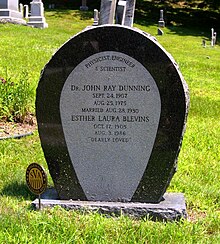John R. Dunning
| John R. Dunning | |
|---|---|

John Dunning grave North Cemetery Sherman, Fairfield County, Connecticut
|
|
| Born | September 24, 1907 Shelby, Nebraska |
| Died |
August 25, 1975 (aged 67) Key Biscayne, Florida |
| Nationality | American |
| Fields | physics |
| Thesis | The Emission and Scattering of Neutrons (1934) |
| Doctoral advisor | George B. Pegram |
| Known for | atomic bomb |
| Notable awards | Medal for Merit (1946) |
John Ray Dunning (September 24, 1907 – August 25, 1975) was an American physicist who played key roles in the Manhattan Project that developed the first atomic bombs. He specialized in neutron physics, and did pioneering work in gaseous diffusion for isotope separation. He was Dean of the School of Engineering and Applied Science at Columbia University from 1950 to 1969.
John Ray Dunning was born in Shelby, Nebraska, on September 24, 1907, the son of Albert Chester Dunning, a grain dealer, and his wife Josephine Dunning née Thelen. He graduated from Shelby High School in 1925,and entered Nebraska Wesleyan University where he became a member of Phi Kappa Tau fraternity, and received a Bachelor of Arts (B.A.) degree in 1929.
After graduation, Dunning commenced a doctoral program at Columbia University. In 1932, James Chadwick discovered the neutron, which influenced Dunning's career, as he thereafter devoted much of his professional interest to the characteristics and uses of this particle. Dunning's research was enthusiastically supported at Columbia by George B. Pegram. In 1933, Dunning was an instructor at Columbia University from 1929 to 1932, and a university fellow from 1932 to 1933. He received his Ph.D. in 1934, writing his thesis on "The Emission and Scattering of Neutrons" under Pegram's supervision.
Dunning married Esther Laura Blevins in 1930. They had two children, John Ray, Jr., who became a Professor of Physics and Astronomy at Sonoma State University, and Ann Adele.
After gaining his doctorate at Columbia, Dunning continued teaching and research there, becoming an assistant professor in 1935, and an associate professor there in 1938. Dunning was a central figure at Columbia on neutron research, and went on to publish 24 papers on neutrons between 1934 and 1938. In 1936, Dunning received a Traveling Fellowship, which he used to meet and discuss his neutron physics research with many eminent European nuclear physicists including Niels Bohr, James Chadwick, Fermi, Werner Heisenberg, and Ernest Rutherford.
...
Wikipedia
